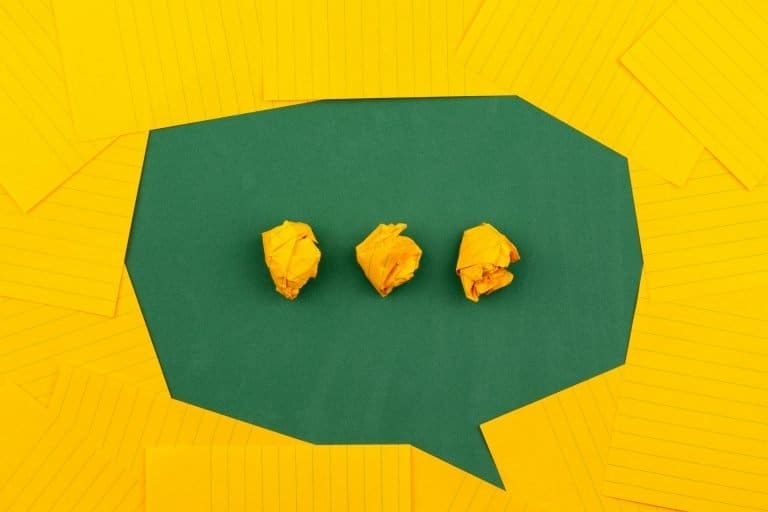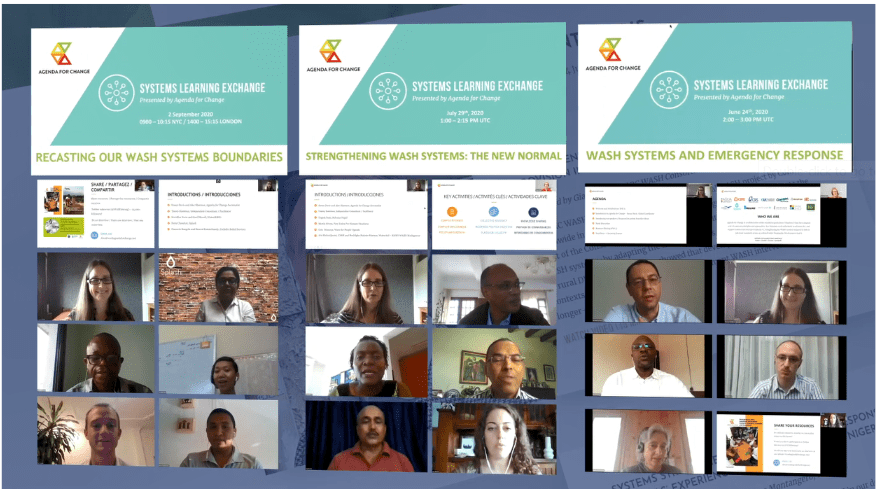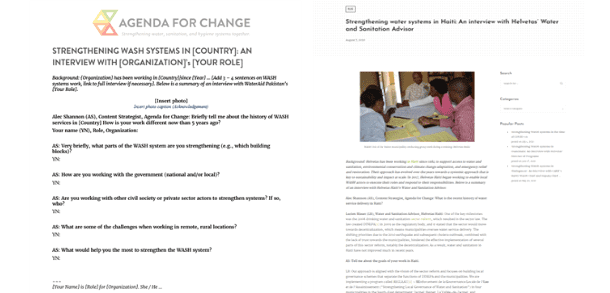Effective collaboration cannot happen without considering inclusivity. At Agenda for Change, we have realized that changing systems and influencing the water, sanitation, and hygiene (WASH) sector will require communicating differently. Below are five steps on our journey to advancing effective, inclusive WASH communications.

Volodymyr Hryshchenko (Unsplash)
By Alec Shannon, Content Strategist at Agenda for Change
I joined Agenda for Change in 2019 as a Content Strategist with the goal of curating, translating, and sharing knowledge across our membership and with external audiences[1]. This included helping the collaboration to support and influence audiences spanning races, genders, languages, and regions of the world, including:
- Our members (14 organizations, mostly non-profits, varied in size and resources)
- Development organizations working on WASH and other related fields
- Government representatives
- Funding and financing organizations
Supporting diverse audiences requires translating, editing, and simplifying content to be understood across varying levels of knowledge, learning styles, cultural norms, and languages – which is no small task! When I started researching how to begin this journey towards global inclusion, I found there was little information readily available from our peers in the WASH field. So, I have looked to other organizations, both non-profits and for-profits, for inspiration, and done some experimenting with different methods to figure out what works and what still needs work. To help others, I have compiled some practical steps we took on our journey.
Step 1: Determining our starting point
Before we could embark on our journey to be more inclusive in our communications, we needed to understand where we were starting from. When I joined Agenda for Change, we had a variety of formal knowledge sharing activities. Each had benefits, but since we’re talking about inclusion I’m highlighting some of the limitations:
Step 2: Make the message pop – and stick!
Together, our members have thousands of staff and even more stakeholders around the world. We have come to realize many of the staff from our member organizations were not familiar with Agenda for Change and the opportunities available to learn and share their work with each other. Further, our members and others were confused about how Agenda for Change is different from similar global and local networks and alliances.
Branding. One first step was to provide some consistency in how members use the brand name, logo, fonts, colors, and voice of the collaboration, with guidance from our Communications and Knowledge Management Working Group and help from a branding consultant. After five years, it was time for an update of our logo too. A new branding package (2,900 to 3,300 USD) includes recommended text for members to explain who we are, what we do, and how we do it. Our new logo (below, right) adds some systems imagery and color. The delta symbols (triangle shapes) depict change, and the “traffic light” colors reflect a national systems strength assessment.
 Our new logo (right) adds some color and clarity to what we do
Our new logo (right) adds some color and clarity to what we do
Website. Once we finished with our branding, we were able to begin work on an updated website (ranging from 7,500 to 11,300 USD for full configuration, not including plug-ins or additional graphic design). With this website update, we continue to professionalize our online presence and make it easier for people to find information on:
- Who are we and what we do
- What is WASH systems strengthening and why is it important?
- Who are our members, and where do they work on WASH systems strengthening?
- Highlights of country-level systems strengthening activities, collaboration, and evidence (the “how”)
- Resources and tools
 Screenshots from our updated website
Screenshots from our updated website
Step 3: De-colonize content
Since most staff from our member organizations are in Latin America, Europe, and Western Africa, we started offering content and events in French and Spanish, in addition to English.
- We hired consultants to translate our main policy documents and presentations into English, French, and Spanish, and made them available on our website. Translation costs vary from 0.08 to 0.12 USD per word. We initially relied on our colleagues to recommend translators, though we also successfully used Upwork for quick jobs.
- We added buttons to our homepage that allow readers to quickly translate any page to English, French, or Spanish. We used a WordPress plug-in called TranslatePress (79 USD per year), which can link with Google Translate (up to 10 USD per month), or DeepL (around 18 USD per month).
 Translation buttons are easy to find in the top right corner of our homepage
Translation buttons are easy to find in the top right corner of our homepage
- In most of our global emails, we include instructions at the top in French and Spanish for how to view the text in a separate browser (using DeepL). For newsletters, MailChimp offers translation in about 50 languages using their viewer in the web browser. Both are free to use.
- Agenda for Change webinars and presentations that were recorded in Zoom or other online platforms now include subtitles (closed captions) in English, French, and Spanish. Subtitles are added during the video editing process at a cost of 350 USD per day per video, and the translation of subtitles costs between 0.10 – 0.12 USD per word.
Step 4: Invite, innovate, and interpret
Due to COVID-19, we cancelled an in-person learning event planned for May 2020; instead, we created a series of online events. While we were initially worried about missing out on face to face learning, the bright side was that we could expand the speakers and audience to include people who might not be comfortable presenting in English, or who normally wouldn’t have the time or budget to attend an event in London. The relatively low costs also provided us the opportunity to help members learn from each other in creative ways.
- For the entire series, we hired a facilitator to coach our speakers to develop 10 – 15-minute video presentations in their language of choice. This facilitation costs between 300 to 700 USD per day. Good quality recordings were possible using Skype, Google, and Zoom, even in places with low or limited internet connectivity. Making these video presentations available in advance allowed more time for discussion during the live webinar (and we avoided potential connection issues on the day of, too).
- We hired interpreters so that people could speak and listen in English, French, or Spanish. The Zoom webinar platform has an interpretation feature that allows viewers to select a language channel. We paid 360 – 400 USD per interpreter per webinar; this included their time for a 1-hour test webinar (highly recommended!), 1 hour and 15 minutes of live interpretation during the webinar, and any reflections on the process and logistics afterwards.
- For the first two events, the video presentations were like what you would see at a technical conference: PowerPoint slides. By the time we reached the third event, our facilitator had encouraged the speakers to have an engaging conversation with her without needing to rely on slides. This format has added benefits for accessibility and inclusion too, as PowerPoint slides are rarely translated.
 Our three-part online learning exchange featured speakers from 10 countries
Our three-part online learning exchange featured speakers from 10 countries
- By the time we learned that Stockholm World Water Week was going to be an online event, we knew we needed to provide time for learning, but also ways to network – which I know is many peoples’ favorite part of going to Stockholm. To allow participation at convenient times, we and our fellow organizers co-created three events across three time zones: New York, Stockholm, and Sydney. These were surprisingly popular – over 600 people from 75 countries registered to attend (compared to 80 attendees during a similar in-person event in Stockholm in 2019).
Step 5: Smooth the path for sharing
Our members are committed to real and lasting change, but let’s face it, this work is exhausting and it’s tough to do anything extra. With that in mind, we are changing our methods for how we collect knowledge from the experts.
Talk before templates! Sorry, not sorry: filling in a template that doesn’t fit the way you write or think is a pain. Rather than beg people to fill in an outline (or spreadsheets, for that matter), I have found that conducting short interviews with a set of predetermined questions was easier to coordinate and provided richer information. Additionally, it was a great opportunity for me to build relationships with our members and learn more about their work.
It’s easier to critique than create. It is typically much easier to find information ourselves and then ask our colleagues to correct or fill in gaps. For instance, we created a Google doc for country updates based on information we already had or could easily find. All members have access to this, and we remind them every so often to add updates and links to related resources. This process helped to realize that our members are doing systems strengthening in more than 40 countries!
Tech saves time. As noted above, instead of asking people to write their own blogs or briefs, I often conduct short interviews with member staff to share their country-specific lessons. I record these interviews via Zoom and use Temi to transcribe the audio quickly into a Word document – this typically costs around 10 USD for a 30-minute interview. Then I edit the interviews into a short question and answer blog, which can also feature relevant videos, reports, or websites with more details. Since starting this process, I have conducted 13 interviews with members from 10 countries, and learned a lot about their work in the process.
 The template on the left is the base for an interview blog and on the right is a finished product
The template on the left is the base for an interview blog and on the right is a finished product
Wonderful words or wonder-full words? Our audiences have various levels of understanding around what WASH systems strengthening is, how it’s different from “traditional” WASH approaches, and why it’s important. As a start, we compiled a glossary of WASH systems terms from Agenda for Change, our members, and other WASH systems leaders (now on our website in English, French, and Spanish).
Our journey continues …
Looking at our progress, there is no doubt that changing our communications has paid off! Over the last nine months, we had close to 900 participants from 78 countries register to attend our events. Also, this approach has allowed us to attract new member representatives and integrate them into our subscription platforms, and our followers and engagement across social media channels have continued to grow. Some of our members are asking me how they might incorporate some of these steps into their own communications products or events. That was part of my inspiration for sharing these steps: I hope these can serve as a roadmap for other organizations like ours who are looking to make a shift but may not know where to start.
Interested in learning more? Stay tuned for Part 2 to find out what we’ve learned along the way, how we’ve incorporated feedback, and how we plan to keep improving.
[1] I was lucky to have the support and guidance of WASH communications experts from our Communications and Knowledge Management Working Group. Before I arrived, they had done much of the work to get the collaboration up and running, including the development of both our website and a Knowledge Management strategy, among other guidance documents.

Alec Shannon (she/her) is Content Strategist at Agenda for Change where she supports the mission of the collaboration through planning, curation, translation, and distribution of evidence across members and other systems actors. She has been working in the WASH sector for more than 7 years, and has provided programmatic guidance, technical assistance, and communications support to WASH, menstrual health, and community-led total sanitation projects throughout her career. She is passionate about shaking things up in development, and finding new, creative, and inclusive ways of working.
